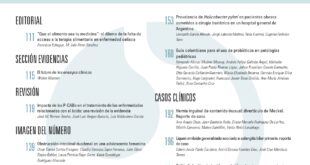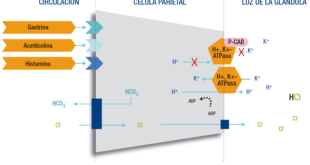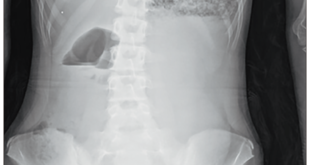Francisco Echague · M. Inés Pinto-Sánchez ID
Farncombe Family Digestive Health Research Institute, McMaster University, Hamilton, ON, Canadá.
Acta Gastroenterol Latinoam 2024;54(2):111-112
Recibido: 12/05/2024 / Aceptado: 24/06/2024 / Publicado online el 30/06/2024 / https://doi.org/10.52787/agl.v54i2.415
Presentación del caso
La enfermedad celíaca (EC) es la única patología autoinmune en la cual se conoce el principal desencadenante: el gluten.1 Es así que la adherencia a una estricta dieta libre de gluten (DLG) es esencial en las personas con EC para la recuperación de la mucosa intestinal, el alivio sintomático y la reducción del riesgo de complicaciones como anemia ferropénica, fracturas osteoporóticas y cáncer de intestino delgado.2 Sin embargo, el estricto cumplimiento de la DLG puede dificultarse debido a desafíos sociales y sobre todo por los altos costos de los alimentos libres de gluten.3 Estudios en diferentes poblaciones en Norte América y Europa reportan un costo entre 4 y 5 veces mayor en los alimentos libres de gluten comparado aquellos que contienen gluten.4 Esto es particularmente problemático para quienes dependen de estos alimentos para mantener su salud, como en el caso de la EC. Más aún, el apoyo económico de los diferentes sistemas de gobierno para subsidiar los costos de la DLG es variable y dependiente de cada país y región. Frecuentemente este reembolso o apoyo económico es insuficiente, sobre todo para aquellas personas con ingresos medios o bajos, creando desigualdades en el acceso al tratamiento.3 Como resultado, la falta de acceso a los alimentos libres de gluten (ALG) determina una disminución en la adherencia a la DLG,5 lo cual puede explicar en parte la persistencia de síntomas luego de iniciado el tratamiento, al menos en una proporción de los pacientes celíacos.
Un estudio multicéntrico recientemente publicado en esta revista,6 analizó por primera vez el costo y la disponibilidad de varios ALG en diferentes poblaciones de Argentina, evaluando su composición nutricional y su relación con la adherencia al tratamiento de la EC. En este estudio se observó que el costo de la canasta básica de la persona con EC es casi 70% superior a la canasta básica general, relacionado a un incremento del 250% en el costo de los ALG sustitutivos comparado a sus homólogos con gluten. Más aún, los ALG presentaron un déficit de macronutrientes y micronutrientes importantes, con un 39% menos de proteínas y un 68% menos de fibra, como también disminución de hierro y vitaminas del complejo B, en comparación con sus homólogos con gluten. Otro aspecto importante evaluado en este estudio fue la disponibilidad de ALG, la cual fue significativamente menor en almacenes comparado con supermercados o dietéticas. Consecuentemente, uno cada 4 (25%) de los pacientes celíacos encuestados reportaron que el costo influye en la adherencia a la DLG.
Este estudio confirma el problema que ocasiona la falta de acceso a los alimentos, particularmente en la EC, en la cual el alimento es la medicina. Para los pacientes celíacos, el acceso a la DLG es necesario para el buen control de su enfermedad, de sus síntomas y prevenir complicaciones. La falta de acceso a DLG determina una selección de alimentos ricos en calorías y pobres en nutrientes, el cual es un patrón dietético reconocido como poco saludable asociado con el síndrome metabólico y aumento en el riesgo de enfermedad cardiovascular.4 Es así como una DLG de inadecuada calidad nutricional conduce a mayores tasas de sobrepeso y obesidad,7 y a complicaciones metabólicas, incluida la enfermedad del hígado graso, que es cada vez más frecuente en celíacos.8 La composición de la DLG y la selección de alimentos contribuyen en gran parte a este problema. Es más, los ALG ultraprocesados tienen un alto contenido de grasas, azúcar y aditivos, lo cual se asocian a incremento en la inflamación,9,10 agravando el problema más allá del control de la EC y sus complicaciones.
Los resultados de González y col.6 nos permite identificar puntos críticos del tratamiento clínico-nutricional en la EC, y abordar estos aspectos es importante para un adecuado manejo y seguimiento de los pacientes con EC. La frase tan citada de Hipócrates “Que el alimento sea tu medicina y la medicina sea tu alimento”, que data desde el año 400 a.c. nunca ha sido más relevante, aunque no siempre posible, especialmente en el celíaco. La falta de acceso a la DLG relacionado al alto costo de los ALG es uno de los problemas principales a abordar, ya que esto impactará tanto en la adherencia al tratamiento, como en la selección de alimentos, ambos aspectos cruciales en el manejo de la EC y en la prevención de complicaciones clínicas, nutricionales y metabólicas.
Financiamiento. M. Inés Pinto-Sánchez recibió una beca de AFP Gastroenterology Division and HAHSO AFP Innovation grant Project # HAH-22-002, JACampbell award from Celiac Canada y una beca de Educación financiada por Takeda.
Conflicto de interés. Francisco Echague no reporta conflictos de interés. MIPS recibió honorarios de consultoría de Takeda y financiación de investigación de ProventBio no relacionados a esta editorial.
Aviso de derechos de autor
© 2024 Acta Gastroenterológica Latinoamericana. Este es un artículo de acceso abierto publicado bajo los términos de la Licencia Creative Commons Attribution (CC BY-NC-SA 4.0), la cual permite el uso, la distribución y la reproducción de forma no comercial, siempre que se cite al autor y la fuente original.
Cite este artículo como: Echague F y Pinto-Sánchez M I. “Que el alimento sea tu medicina”: el dilema de la falta de acceso a la terapia alimentaria en enfermedad celíaca. Acta Gastroenterol Latinoam. 2024;54(2):111-112. https://doi.org/10.52787/agl.v54i2.415
Referencias
- Catassi C, Verdu EF, Bai JC, Lionetti E. Coeliac disease. Lancet 2022;399(10344):2413-26.
- Kivelä L, Caminero A, Leffler DA, et al. Current and emerging therapies for coeliac disease. Nature Rev Gastroenterol Hepatol 2020 Nov 20;1-15.
- Pinto-Sanchez MI, Verdu EF, Gordillo MC, et al. Tax-deductible provisions for gluten-free diet in Canada compared with systems for gluten-free diet coverage available in various countries. Can J Gastroenterol Hepatol 2015;29(2):104-10.
- Babio N, Lladó Bellette N, Besora-Moreno M, et al. A comparison of the nutritional profile and price of gluten-free products and their gluten-containing counterparts available in the Spanish market. Nutr Hosp. 2020 Aug 27;37(4):814-822.
- Hall N. J., Rubin G., Charnock A. Systematic review: adherence to a gluten-free diet in adult patients with celiac disease. Aliment Pharmacol Ther 2009;30:315-330.
- Gonzalez A, Temprano MP, Costa F et al. Costo, disponibilidad y valor nutricional de los alimentos libres de gluten en Argentina. Su relación con la adherencia a la dieta libre de gluten. Estudio multicéntrico Acta Gastroenterol Latinoam 2023;53(3):257-264.
- Pinto-Sanchez MI, Blom JJ, Gibson PR, Armstrong D. Nutrition Assessment and Management in Celiac Disease. Gastroenterology. 2024 Jun;167(1):116-131.e1.
- Aggarwal N, Agarwal A, Alarouri H, Dwarakanathan V, Dang S, Ahuja V, Makharia GK. Patients with Celiac Disease Have High Prevalence of Fatty Liver and Metabolic Syndrome. Dig Dis Sci. 2024 Apr 25.
- Moubarac JC. Ultra-processed foods in Canada: consumption, impact on diet quality and policy implications. In: Montreal: TRANSNUT, University of Montreal; 2017.
- Narula N, Chang NH, Mohammad D, Wong ECL, Ananthakrishnan AN, Chan SSM, Carbonnel F, Meyer A. Food Processing and Risk of Inflammatory Bowel Disease: A Systematic Review and Meta-Analysis. Clinical Gastroenterology and Hepatology. 2023;21:2483-2495.e2481. DOI:https://doi.org/10.1016/j.cgh.2023.01.012
Correspondencia: M. Ines Pinto-Sanchez
Correo electrónico: pintosm@mcmaster.ca
Acta Gastroenterol Latinoam 2024;54(2):111-112
«Let Food Be Your Medicine»: the Dilemma of Lack of Access to Food Therapy in Celiac Disease
Francisco Echague · M. Inés Pinto-Sánchez ID
Farncombe Family Digestive Health Research Institute, McMaster University, Hamilton, ON, Canada.
Acta Gastroenterol Latinoam 2024;54(2):113-114
Received: 12/05/2024 / Accepted: 24/06/2024 / Published online 30/06/2024 / https://doi.org/10.52787/agl.v54i2.415
Case Presentation
Celiac disease (CD) is the only autoimmune condition in which the main trigger is known: gluten.1 Thus, adherence to a strict gluten-free diet (GFD) is essential in people with CD for the recovery of the intestinal mucosa, symptomatic relief, and reduction of the risk of complications such as iron deficiency anemia, osteoporotic fractures, and intestinal cancer.2 However, strict compliance with the GFD can be challenging due to social challenges and primarily due to the high cost of gluten-free foods.3 Studies in different populations in North America and Europe report a price between 4 to 5 folds higher for gluten-free foods than those containing gluten.4 This is particularly problematic for those who rely on these foods to maintain their health, as with CD.
Furthermore, the different government systems’ financial support to subsidize the GFD’s costs is variable and dependent on each country and region. Frequently, this reimbursement or financial support is insufficient, especially for those people with medium or low income, creating inequalities in access to treatment.3 As a result, the lack of access to gluten-free foods (GFF) determines a decrease in adherence to the GFD,5 which may partly explain the persistence of symptoms after starting treatment, at least in a proportion of patients with CD.
A multicenter study recently published in this journal6 analyzed the cost and availability of various GFF in different populations in Argentina for the first time, evaluating their nutritional composition and its relationship with adherence to CD treatment. In this study, the cost of the basic basket of the person with CD was almost 70% higher than the general basic basket, which is related to a 250% increase in the cost of substitute GFF compared to their counterparts with gluten. Furthermore, GFF presented a deficiency of essential macronutrients and micronutrients, with 39% less protein and 68% less fibre and a decrease in iron and B complex vitamins compared to their counterparts with gluten. Another critical aspect evaluated in this study was the availability of GFF, which was significantly lower in stores than in supermarkets or health food stores. Consequently, one in four (25%) of CD patients surveyed reported that the high cost of GFF influences their adherence to GFD.
This study confirms the problem caused by lack of access to food, particularly in CD, in which food is their medicine. For celiac patients, access to GFD is necessary for adequate control of their disease and its symptoms and to prevent complications. Lack of access to GFD determines a selection of foods rich in calories and poor in nutrients, a dietary pattern recognized as unhealthy and associated with metabolic syndrome and increased risk of cardiovascular disease.4 This is how a GFD of inadequate nutritional quality may lead to higher rates of overweight and obesity7 and to metabolic complications, including fatty liver disease, which is increasingly common in celiac patients.8 The composition of the GFD and food selection largely contribute to this problem. Furthermore, ultra-processed GFF have a high content of fats, sugar and additives, which are associated with increased inflammation,9,10 aggravating the issue beyond the control of CD and its complications.
The results of González et al.6 allow us to identify critical points of the clinical and nutritional treatment in CD, and addressing these aspects is essential for adequate management and follow-up of CD patients. Hippocrates’ often-quoted phrase, «Let food be thy medicine and medicine be thy food,» has never been more relevant, but unfortunately, it is not always possible, especially in celiac patients. There is an urgent need to address the lack of access to GFD related to the high cost of GFD since this will impact treatment adherence and food selection, both crucial aspects in managing CD and preventing clinical, nutritional and metabolic complications.
Funding. M. Inés Pinto-Sánchez received a grant from AFP Gastroenterology Division and HAHSO AFP Innovation grant Project # HAH-22-002, JACampbell award from Celiac Canada and an Education grant funded by Takeda.
Conflict of interest. Francisco Echague does not report conflicts of interest. MIPS received consulting fees from Takeda and research funding from ProventBio unrelated to this editorial.
Copyright
© 2024 Acta Gastroenterológica latinoamericana. This is an open-access article released under the terms of the Creative Commons Attribution (CC BY-NC-SA 4.0) license, which allows non-commercial use, distribution, and reproduction, provided the original author and source are acknowledged.
Cite this article as: Echague F and Pinto-Sánchez M I. «Let food be your medicine»: the dilemma of lack of access to food therapy in celiac disease. Acta Gastroenterol Latinoam. 2024;54(2):113-114. https://doi.org/10.52787/agl.v54i2.415
References
- Catassi C, Verdu EF, Bai JC, Lionetti E. Coeliac disease. Lancet 2022;399(10344):2413-26.
- Kivelä L, Caminero A, Leffler DA, et al. Current and emerging therapies for coeliac disease. Nature Rev Gastroenterol Hepatol 2020 Nov 20;1-15.
- Pinto-Sanchez MI, Verdu EF, Gordillo MC, et al. Tax-deductible provisions for gluten-free diet in Canada compared with systems for gluten-free diet coverage available in various countries. Can J Gastroenterol Hepatol 2015;29(2):104-10.
- Babio N, Lladó Bellette N, Besora-Moreno M, et al. A comparison of the nutritional profile and price of gluten-free products and their gluten-containing counterparts available in the Spanish market. Nutr Hosp. 2020 Aug 27;37(4):814-822.
- Hall N. J., Rubin G., Charnock A. Systematic review: adherence to a gluten-free diet in adult patients with celiac disease. Aliment Pharmacol Ther 2009;30:315-330.
- Gonzalez A, Temprano MP, Costa F et al. Costo, disponibilidad y valor nutricional de los alimentos libres de gluten en Argentina. Su relación con la adherencia a la dieta libre de gluten. Estudio multicéntrico Acta Gastroenterol Latinoam 2023;53(3):257-264.
- Pinto-Sanchez MI, Blom JJ, Gibson PR, Armstrong D. Nutrition Assessment and Management in Celiac Disease. Gastroenterology. 2024 Jun;167(1):116-131.e1.
- Aggarwal N, Agarwal A, Alarouri H, Dwarakanathan V, Dang S, Ahuja V, Makharia GK. Patients with Celiac Disease Have High Prevalence of Fatty Liver and Metabolic Syndrome. Dig Dis Sci. 2024 Apr 25.
- Moubarac JC. Ultra-processed foods in Canada: consumption, impact on diet quality and policy implications. In: Montreal: TRANSNUT, University of Montreal; 2017.
- Narula N, Chang NH, Mohammad D, Wong ECL, Ananthakrishnan AN, Chan SSM, Carbonnel F, Meyer A. Food Processing and Risk of Inflammatory Bowel Disease: A Systematic Review and Meta-Analysis. Clinical Gastroenterology and Hepatology. 2023;21:2483-2495.e2481. DOI:https://doi.org/10.1016/j.cgh.2023.01.012
Correspondence: M. Ines Pinto-Sanchez
Mail: pintosm@mcmaster.ca
Acta Gastroenterol Latinoam 2024;54(2):113-114
 Revista ACTA Órgano Oficial de SAGE
Revista ACTA Órgano Oficial de SAGE





